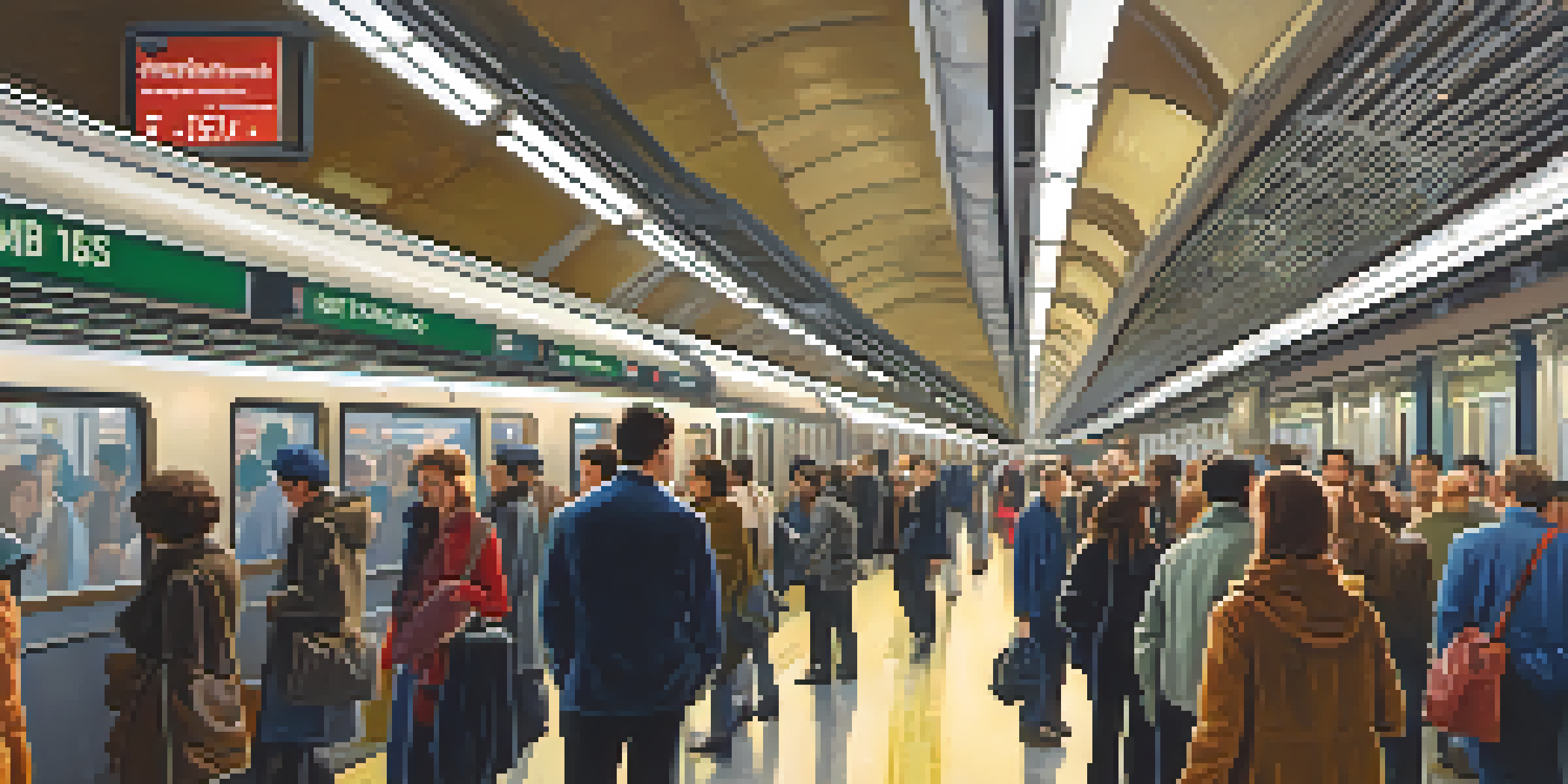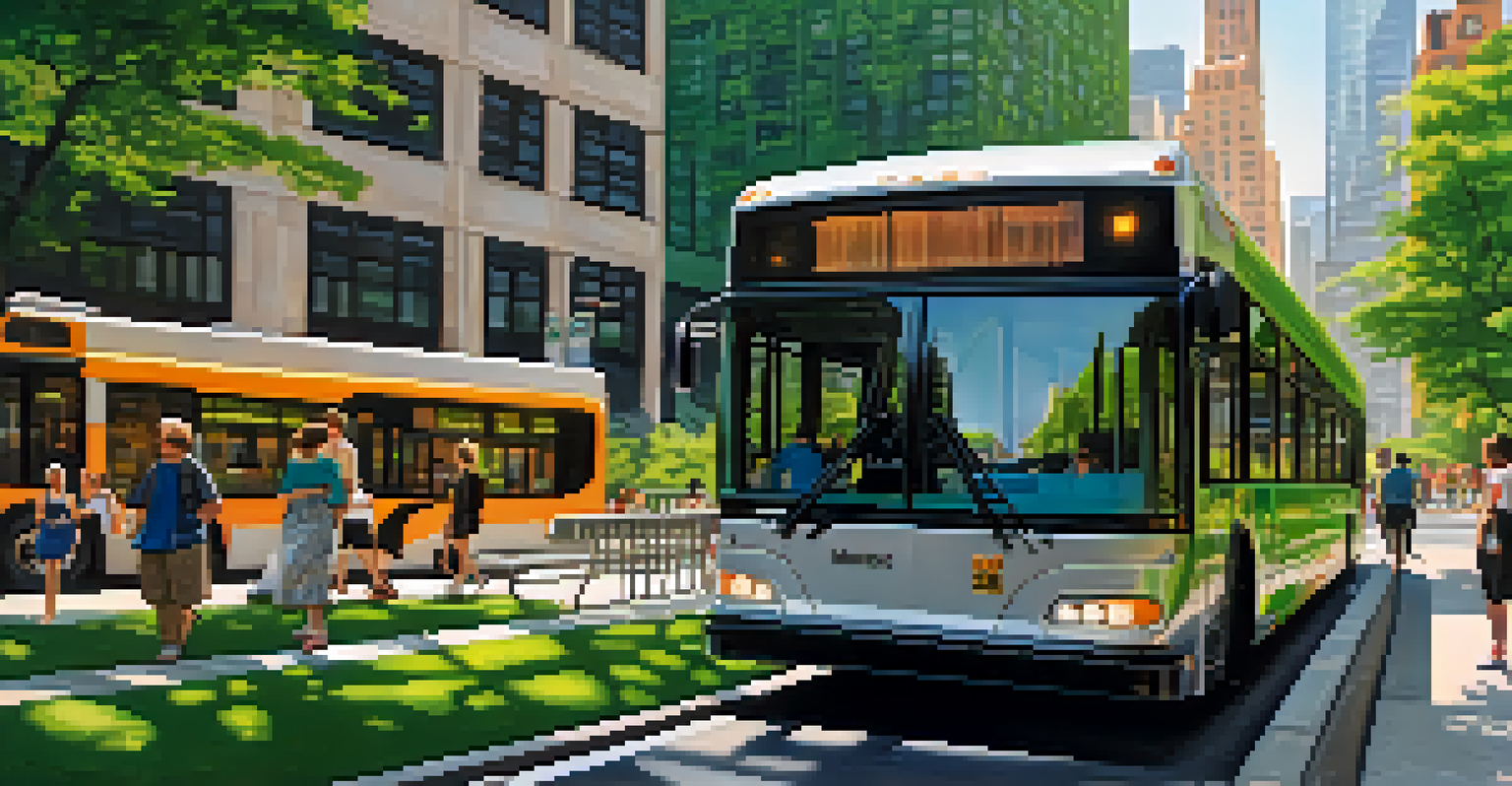Public Transportation Upgrades: Shaping NYC's Urban Landscape

The Need for Modernized Public Transportation in NYC
New York City's public transportation system has long been the lifeblood of the city, but it's no secret that it has faced numerous challenges over the years. Aging infrastructure and increased ridership have led to overcrowding and delays, making daily commutes frustrating for many residents. As the city continues to grow, the demand for efficient and reliable transport options has become more pressing, prompting the need for significant upgrades.
Public transportation is the backbone of any city. When we invest in it, we invest in our community's future.
These upgrades are not just about fixing what's broken; they’re about reimagining how New Yorkers navigate their metropolis. Modernizing public transportation means incorporating technology to enhance user experience, such as real-time tracking and improved signage. By addressing these issues head-on, NYC aims to create a more welcoming and efficient transit system for everyone.
Ultimately, a modernized public transportation system is essential for fostering economic growth and reducing the city’s carbon footprint. As more people turn to public transit, it lessens the reliance on personal vehicles, leading to decreased congestion and pollution. This shift can help reshape NYC into a cleaner, more sustainable urban environment.
Key Upgrades: Expanding Subway and Bus Services
One of the most impactful upgrades to NYC's public transportation is the expansion of subway lines and bus services. The Metropolitan Transportation Authority (MTA) has undertaken several projects aimed at reaching underserved neighborhoods, ensuring that everyone has access to reliable transit options. For example, the Second Avenue Subway project is a significant step in alleviating congestion on the East Side of Manhattan.

In addition to expanding routes, improvements in bus rapid transit (BRT) systems are gaining traction. BRT provides a faster, more efficient alternative to traditional bus services by implementing dedicated lanes and advanced traffic signal technology. These enhancements can drastically reduce travel times and make public transit a more appealing option for daily commuters.
Modernizing NYC's Transit System
NYC's public transportation needs significant upgrades to enhance efficiency, reduce congestion, and improve the overall rider experience.
Moreover, these upgrades aren’t just about adding more vehicles; they also focus on enhancing the overall rider experience. Modern buses and trains come equipped with comfortable seating, Wi-Fi access, and charging stations, making commutes more enjoyable. By improving both capacity and comfort, NYC’s public transportation can compete with personal vehicles.
Integrating Technology for a Seamless Experience
Technology plays a crucial role in the modernization of NYC's public transportation system. The introduction of mobile apps that provide real-time updates on train and bus schedules has transformed how riders plan their journeys. With this instant access to information, commuters can make more informed decisions and better manage their time.
Transportation is a fundamental building block of a vibrant economy and a sustainable environment.
Additionally, contactless payment systems have made fare collection quicker and more efficient. Riders can now use their smartphones or transit cards to pay for their trips, reducing wait times at stations and making the overall experience smoother. This technological integration not only enhances convenience but also encourages more people to choose public transportation over driving.
As NYC continues to embrace new technologies, the potential for further upgrades is vast. Innovations like digital kiosks providing directions and information, as well as advanced analytics to optimize service routes, are just the beginning. By leveraging technology, NYC can create a transit system that is not only more efficient but also more user-friendly.
Sustainability Initiatives in Public Transit
In recent years, sustainability has become a key focus in public transportation upgrades. NYC is investing in electric buses and energy-efficient trains to reduce emissions and promote cleaner air. This shift towards greener alternatives aligns with the city’s broader goals of combating climate change and creating a healthier urban environment.
Moreover, the implementation of green infrastructure in transit projects is helping to manage stormwater and improve local ecosystems. By incorporating rain gardens and permeable pavement in transit hubs, NYC is addressing environmental challenges while enhancing public spaces. These initiatives not only benefit the environment but also provide aesthetic improvements to neighborhoods.
Sustainability in Public Transit
Investments in electric buses and green infrastructure reflect NYC's commitment to reducing emissions and promoting a healthier urban environment.
Sustainability in public transit is about more than just environmental impact; it also promotes social equity. By ensuring that everyone has access to clean and efficient transportation options, NYC can foster a more inclusive city where residents can thrive. This commitment to sustainability reflects the city’s values and dedication to a better future.
Community Involvement in Transit Planning
Community engagement is essential in shaping the future of NYC's public transportation. Local residents, businesses, and organizations have valuable insights into the specific needs and challenges faced by their neighborhoods. By incorporating community feedback into transit planning, the MTA can create services that genuinely reflect the demands of the people they serve.
Public forums and surveys provide platforms for residents to voice their opinions and suggest improvements. This collaborative approach ensures that upgrades are not only efficient but also enhance the quality of life for New Yorkers. When people feel heard and involved in the process, it fosters a sense of ownership and pride in their city’s transit system.
Moreover, community involvement can help address issues of equity in public transportation. By understanding the unique challenges faced by marginalized communities, planners can develop targeted solutions that ensure everyone has equitable access to transit services. This inclusive approach is key to building a public transportation system that works for everyone.
The Role of Funding in Future Upgrades
Funding is a critical component of any public transportation upgrade, and NYC is no exception. Securing financial resources for projects can be challenging, especially in a city with competing budget priorities. However, innovative funding strategies, such as public-private partnerships and grants, can play a vital role in advancing transit improvements.
For example, collaborations with private companies can bring in additional resources and expertise, helping to expedite project timelines. Additionally, state and federal grants can provide significant financial support for major infrastructure projects. By diversifying funding sources, NYC can ensure that public transportation upgrades are not stalled due to budget constraints.
Community Involvement is Key
Engaging local residents in transit planning ensures that upgrades meet the unique needs of neighborhoods and promote equitable access to transportation.
Ultimately, a well-funded public transportation system is an investment in the city’s future. It supports economic development, enhances mobility, and contributes to a more sustainable urban environment. As NYC continues to prioritize public transit, securing adequate funding will be essential to realizing its vision for a modern transit system.
Looking Ahead: The Future of NYC's Public Transportation
The future of NYC's public transportation system is bright, with many exciting upgrades on the horizon. As the city continues to innovate and invest in its transit infrastructure, residents can expect a more efficient, accessible, and sustainable system. These advancements will not only improve daily commutes but also reshape how New Yorkers interact with their urban environment.
Moreover, the ongoing commitment to community engagement and sustainability will help ensure that public transportation meets the evolving needs of a diverse population. As new technologies emerge and best practices are adopted from cities around the world, NYC can set a benchmark for public transit excellence. The goal is to create a system that is not only functional but also enhances the overall quality of life.

As we look ahead, it's clear that public transportation will continue to be a driving force in shaping NYC's urban landscape. By prioritizing upgrades and embracing innovation, the city can build a transit system that supports its residents and promotes a vibrant, sustainable future for all.